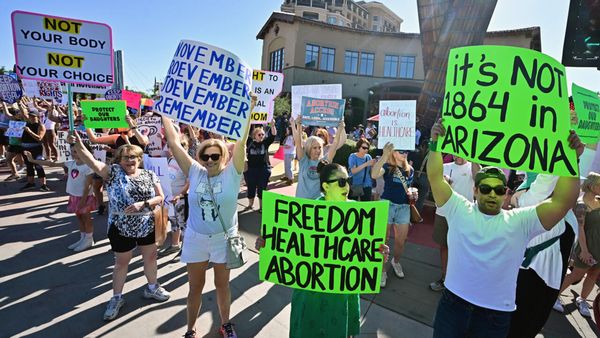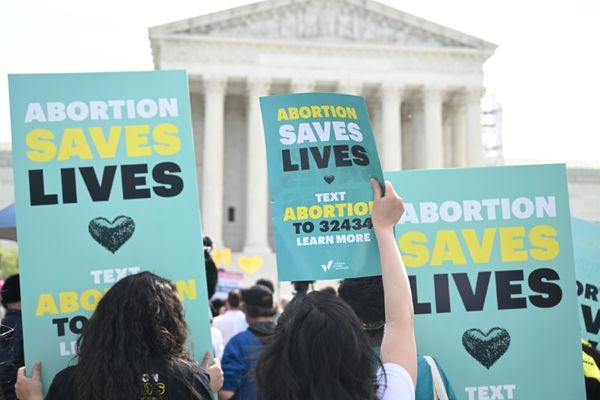
By now, the stories are familiar. Most, though not all, start on social media: a post on Facebook or Twitter identifies a name, and then the threats begin. Shortly after the 2020 presidential election, conspiracy theorists focused on a video of a voting-machine technician at work in Gwinnett County, Georgia. One Twitter user published the young man’s name, declaring him “guilty of treason,” along with, according to the Georgia election official Gabriel Sterling, an animation of a swaying noose. Around that same time, Ruby Freeman, another Georgia election worker, received a flood of menacing emails, texts, and phone calls from people convinced that she had worked to steal the election from Donald Trump, leading her to leave her home and spend months fleeing from house to house. Health-care workers, too, have faced threats. In the fall of 2021, Allison Berry, a local health officer in Washington State, stopped going into the office out of caution following a wave of harassment—including a protest at her former home address—over mask and vaccination requirements imposed in her county.
The federal government appears to be paying attention. In June 2021, the Department of Justice announced the launch of a task force responsible for investigating the sharp increase in threats against election workers. Just four months later, U.S. Attorney General Merrick Garland directed federal law-enforcement officials to work with state and local authorities in addressing violent harassment of school-board members and public-school employees. And two weeks after that, an association of nearly 3,000 public-health departments wrote to Garland asking him to turn the department’s attention toward a comparable surge in threats against health-care workers.
This new focus by the Justice Department on harassment around the country—and the plea by health departments for the federal government to direct even more resources toward the problem—reflects how the ties of basic decency holding American civic life together have become seriously frayed. According to The New York Times, more than 500 top health officials have quit their job since the beginning of the pandemic, many of whom cited threats and intimidation as a decisive factor. One 2021 survey by the publication Education Week found that 60 percent of principals and school administrators said that their employees had been threatened within the past year over the schools’ handling of the coronavirus crisis. And increased violence, or the threat of violence, has also spread to areas of life that might not usually be inflected by politics. The Federal Aviation Administration tallied almost 6,000 reports of “unruly passengers” in 2021, compared with fewer than 150 in 2019. Service workers have struggled to calm dyspeptic customers.
Americans have a tendency to use the Civil War as a measuring stick of sorts for how bad political divides have become. If the acrimony is bad enough, it’s equivalent to reliving 1861; if half the nation hasn’t yet seceded, perhaps we’ll be all right. But the current vogue for harassment is a reminder that violence doesn’t have to take the form of a shooting war with armed militaries or militias to corrode civic life.
[Read: Why people are acting so weird]
This rise in anger is not exclusively an American problem. Incidents of unruly passengers also increased in Canada over the course of 2021, and a majority of respondents to one United Kingdom study carried out in 2020 reported having had arguments, become angry, or ended relationships with others because of the pandemic. Responding to surveys by Nature and the Australian Science Media Centre, researchers who spoke publicly about COVID-19 in the U.K., Germany, Australia, and elsewhere reported persistent harassment in response to their media appearances. Science magazine likewise describes disturbing attacks on scientists studying the pandemic in Canada and the Netherlands, among other places. But in America, the combination of pandemic frustrations along with a polarized public sphere and an extreme right wing makes for a particularly toxic brew. Political disagreement has seeped more and more into every corner of life, and violence and harassment have become more and more mainstream on the right as a tool of politics.
Part of the dynamic has to do with the pandemic, which has made even the smallest tasks into political disputes. Politics is about the weighing of risks and benefits, the question of who is owed what level of care and protection. Deliberations like these are now required every time we decide whether to take that flight to see an elderly relative or eat inside at a restaurant. And masks make immediately visible the sorts of internal calculations and values that were once private. Do you care enough about me to put on a mask, or are you making a different kind of political statement by refusing to wear one?
The pandemic seems to have been all but designed to bring these underlying issues to the surface—a respiratory illness transmitted by close interpersonal contact by nature emphasizes the fraughtness of connection with others. But Trump made the situation much worse, insisting on turning masking into a sign of partisan allegiance. Thanks to his efforts, the decision of whether to mask became a political statement—even in public spaces that hadn’t previously been identified with the divides of our national politics, such as coffee shops and airplanes. In one viral video recorded in October 2020, a white woman refusing to put on a mask in a Southern California Starbucks complains to a Black barista that she’s being discriminated against for her support of the president.
[Peter Wehner: The road to political violence]
Not all public meltdowns are mask-related. One grocery-store employee told The New York Times about a customer who dissolved into a “full temper tantrum” because the store was out of a particular kind of cheese. But videos of Americans throwing fits because they won’t put on a mask have, at this point, become their own genre. In many instances, there’s a certain glee in defying authority on the part of the person refusing to mask up: “This is America,” the customer in the California Starbucks video tells the patient barista. “I don’t have to do what you say.” These confrontations have an echo of Trump’s contempt for rules and delight in flouting them, expressed visually by his own refusal to wear a mask.
Political scientists have written about the increasing nationalization of American politics—the extent to which national politics shapes local outcomes and citizens tend to express more interest in national political disputes over local ones. Along these lines, the transformation of masks and vaccine policy into subjects of partisan division means that issues that would otherwise be matters of purely local concern—like the makeup of a district’s school board—become absorbed into national politics. A livestream of a local school board arguing over the details of the next year’s budget might be interesting to only a handful of nearby parents, but a livestream of angry parents shouting about masking policies is immediately legible to anyone around the country as part of a broader political dispute. The same is true of outrage leveraged by the right over schools teaching students about racial justice: “Unmask our kids and stop dividing us with critical race theory,” demanded one parent at a school-board meeting in Huntley, Illinois. Likewise, Trump’s insistence on spreading lies about election fraud transformed local election officials performing quiet administrative tasks into recipients of nationwide vitriol.
On the right, these clashes speak to the idea of confrontation as a political principle, a way for a silent majority to reassert itself against elite tyranny. “You understand we the people own you,” read one threat to an election worker documented by Reuters. In 2020, Vernon Miller, the health officer for Hot Springs County, Wyoming, received a threatening voicemail message telling him that he was “facing off against this whole goddamn town” after imposing a mask mandate. The caller later told law enforcement that he’d wanted the health officer “to feel the way the rest of us feel”: “helpless and insecure.” Fox’s Tucker Carlson—arguably the most powerful figure in Republican politics other than Trump—encouraged viewers last year to harass people wearing masks outside. “They’re the aggressors,” Carlson argued in an April 2021 segment. “It’s our job to brush them back and restore the society we were born in.”
[David A. Graham: Tucker Carlson, unmasked]
After the Justice Department released Attorney General Garland’s memo on tracking threats against school-board members and other school personnel, Republicans voiced outrage, suggesting that Garland had compared concerned parents to domestic terrorists. The attorney general emphasized in a Senate hearing that the department was concerned only with “violence and threats of violence,” rather than “spirited debate” shielded by the First Amendment. Though it’s appropriate for the Justice Department to draw such a distinction, Garland’s comment also points to the ambiguity often faced by law enforcement in determining whether a threat crosses the line from First Amendment–protected speech to potentially criminal activity.
Screaming at a barista or a school-board official is not the same as committing an act of violence or terrorism—or, for that matter, storming the U.S. Capitol in an effort to overturn an election. But all of these actions exist on a spectrum, and as the Capitol insurrection suggests, the United States has also seen an uptick at the far end of the scale. In January, U.S. Assistant Attorney General Matthew Olsen announced that the Justice Department would create a task force to specifically address domestic terrorism after FBI investigations of violent extremism had “more than doubled since the spring of 2020.” A 2021 poll found that 30 percent of Republicans agreed with the statement that “true American patriots might have to resort to violence in order to save our country.”
To what extent does this all trace back to Trump? Susan Benesch, who studies “dangerous speech” at American University, commented, after a string of violent attacks and attempted attacks in 2018, that “the president’s rhetoric has helped to shift discourse norms in our country such that it is more acceptable among more people to denigrate and attack other groups of human beings.” Analysis suggests that counties that hosted Trump rallies in 2016 were more likely to see an increase in hate crimes in the following months. Reviewing a collection of more than 850 threats made in 2020 and 2021 against election workers, particularly in areas singled out by Trump and his supporters as supposed hotbeds of fraud, Reuters found that harassment sometimes spiked “when new false or baseless allegations of election fraud were made by Trump or his allies, or reported by sympathetic right-wing media outlets.” (The selection of harassing messages “isn’t a statistically representative sample,” the publication noted, but “it offers insights into the nature of this campaign of fear.”)
Reading the accounts of officials terrorized by threatening emails and phone calls, I was struck by how familiar their ordeals seemed to the stories of people facing a deluge of internet harassment before Trump took office. In 2014, during the controversy known as Gamergate, harassers targeting the female game developer Zoë Quinn hacked Quinn’s online accounts, distributed her home address widely online, and placed scores of calls to both Quinn and her family. There are echoes of Quinn’s experiences in the threats encountered by officials such as Al Schmidt, a city commissioner in Philadelphia, who received a barrage of menacing emails and texts in the months and weeks around the 2020 presidential election that eventually led the city to station a security detail around his home. But though many of the the most vicious internet-harassment campaigns often target people vulnerable in some way, including women, men of color, and queer people, coverage of Schmidt’s ordeal has tended to focus on what an unlikely figure he cuts as a victim: a middle-aged white man who was previously well within the mainstream of the Republican Party.
Although this harassment didn’t begin with Trump, in other words, it expanded in scope during his presidency to sweep up even those who have generally been spared such violence. This might have a mirror in the demographics of the people engaging in this kind of intimidation. Loudoun County, Virginia, which has seen some of the most raucous and vicious school-board meetings, is wealthy, suburban, and majority white. Alongside extremist groups such as the Oath Keepers and the Proud Boys on January 6 was a surprising number of people who lacked existing connections to the far right outside their support for Trump—“normal” citizens with stable jobs and families who might otherwise be hailed as respectable members of the community. The Republican National Committee faced backlash when it appeared to characterize the Capitol riot as “legitimate political discourse,” but the GOP outrage over Justice Department efforts to counter threats against school-board members suggests that congressional Republicans might be happy to describe harassment of educators—at least short of physical violence—the same way.
Recently, pundits and journalists have tended to frame worries over the presence of violence in American politics as a question of whether the United States is slipping into a second civil war. There are good reasons to think that the most extreme such scenarios are far-fetched—among them that, as the University of Chicago professor Chris Blattman writes, “letting a civil conflict happen isn’t in anyone’s interests.” But this obsession with the idea of a second fratricidal split also obscures the long presence of violence of other kinds in American life, such as the explicitly ideological attacks conducted by small extremist groups in the 1960s and ’70s and terrorism by white southerners against Black Americans. Those eras of brutality are far from an exact parallel to today, but they are a reminder that violence can persist for a long time without a crescendo into war.
In one sense, the everyday nature of the violence and harassment that have become so prevalent is part of what makes this dynamic so concerning. Trust in government has suffered a sharp decline over the past 50 years, but a study by the Pew Research Center also found that Americans have lost further trust in other public institutions over the course of the pandemic. One solution for these ills is to encourage greater participation in civic life by idealistic Amerians who want to do good. But such encouragement can’t help but be undercut by the new norm that people working in a public-facing job, or in any role that might excite public interest, can expect a potential torrent of abuse at any minute. Many—though not all—stories of health officials, election workers, and school-board members inundated with threats end with the person at the center of the storm stepping back from their work in search of some measure of anonymity. Public service, in their view, is no longer worth it.







